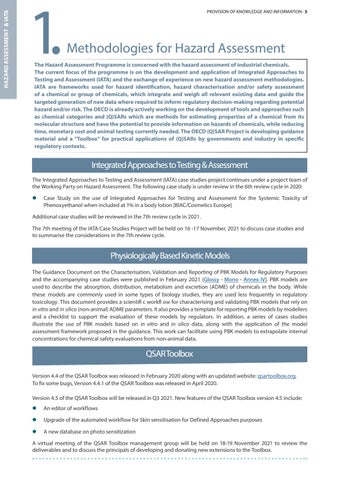HAZARD ASSESSMENT & IATA
1.
PROVISION OF KNOWLEDGE AND INFORMATION . 5
Methodologies for Hazard Assessment
The Hazard Assessment Programme is concerned with the hazard assessment of industrial chemicals. The current focus of the programme is on the development and application of Integrated Approaches to Testing and Assessment (IATA) and the exchange of experience on new hazard assessment methodologies. IATA are frameworks used for hazard identification, hazard characterisation and/or safety assessment of a chemical or group of chemicals, which integrate and weigh all relevant existing data and guide the targeted generation of new data where required to inform regulatory decision-making regarding potential hazard and/or risk. The OECD is already actively working on the development of tools and approaches such as chemical categories and (Q)SARs which are methods for estimating properties of a chemical from its molecular structure and have the potential to provide information on hazards of chemicals, while reducing time, monetary cost and animal testing currently needed. The OECD (Q)SAR Project is developing guidance material and a “Toolbox” for practical applications of (Q)SARs by governments and industry in specific regulatory contexts.
Integrated Approaches to Testing & Assessment The Integrated Approaches to Testing and Assessment (IATA) case studies project continues under a project team of the Working Party on Hazard Assessment. The following case study is under review in the 6th review cycle in 2020: l
Case Study on the use of Integrated Approaches for Testing and Assessment for the Systemic Toxicity of Phenoxyethanol when included at 1% in a body lotion [BIAC/Cosmetics Europe]
Additional case studies will be reviewed in the 7th review cycle in 2021. The 7th meeting of the IATA Case Studies Project will be held on 16 -17 November, 2021 to discuss case studies and to summarise the considerations in the 7th review cycle.
Physiologically Based Kinetic Models The Guidance Document on the Characterisation, Validation and Reporting of PBK Models for Regulatory Purposes and the accompanying case studies were published in February 2021 (Glossy - Mono - Annex IV). PBK models are used to describe the absorption, distribution, metabolism and excretion (ADME) of chemicals in the body. While these models are commonly used in some types of biology studies, they are used less frequently in regulatory toxicology. This document provides a scientifi c workfl ow for characterising and validating PBK models that rely on in vitro and in silico (non-animal) ADME parameters. It also provides a template for reporting PBK models by modellers and a checklist to support the evaluation of these models by regulators. In addition, a series of cases studies illustrate the use of PBK models based on in vitro and in silico data, along with the application of the model assessment framework proposed in the guidance. This work can facilitate using PBK models to extrapolate internal concentrations for chemical safety evaluations from non-animal data.
QSAR Toolbox Version 4.4 of the QSAR Toolbox was released in February 2020 along with an updated website: qsartoolbox.org. To fix some bugs, Version 4.4.1 of the QSAR Toolbox was released in April 2020. Version 4.5 of the QSAR Toolbox will be released in Q3 2021. New features of the QSAR Toolbox version 4.5 include: l
An editor of workflows
l
Upgrade of the automated workflow for Skin sensitisation for Defined Approaches purposes
l
A new database on photo sensitization
A virtual meeting of the QSAR Toolbox management group will be held on 18-19 November 2021 to review the deliverables and to discuss the principals of developing and donating new extensions to the Toolbox.










